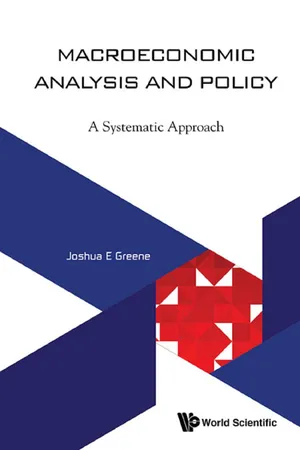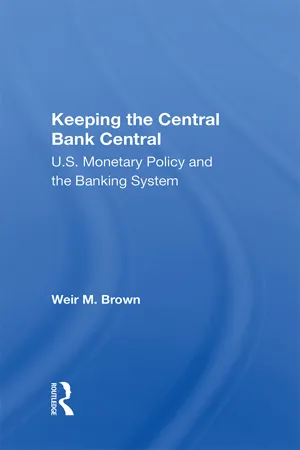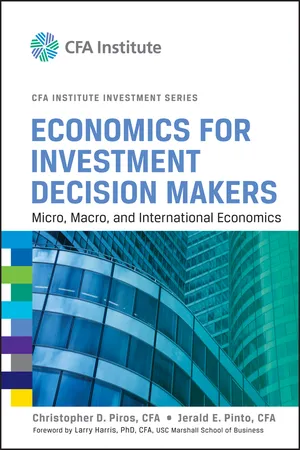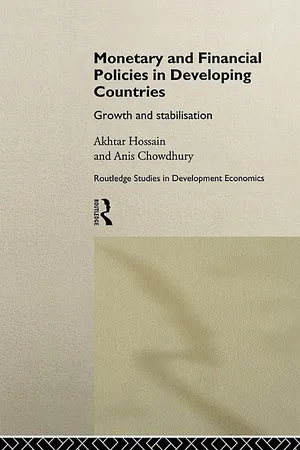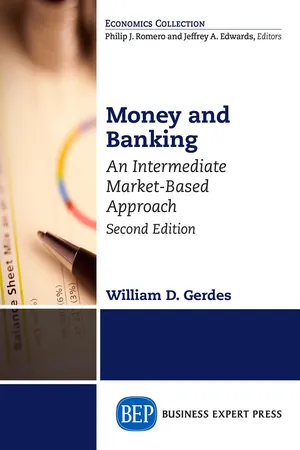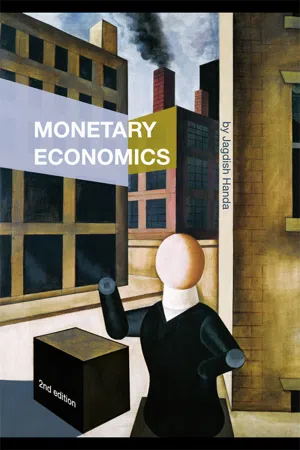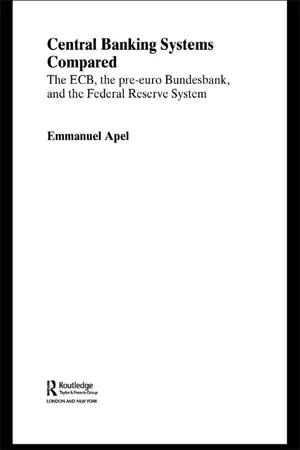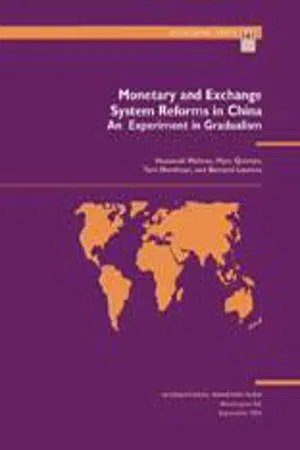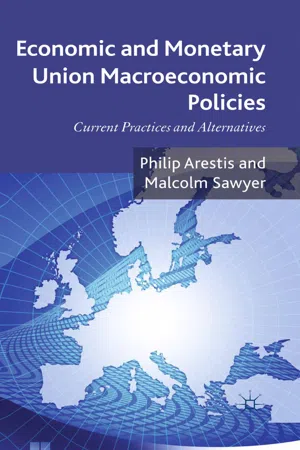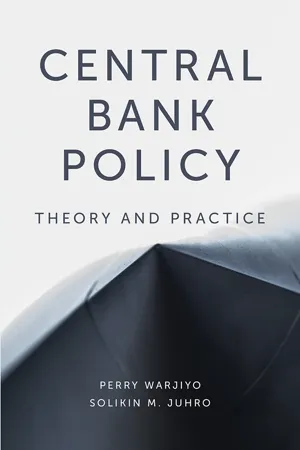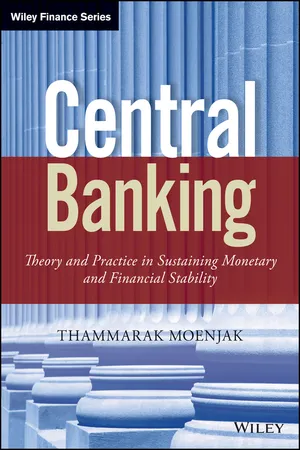Economics
Monetary Policy Tools
Monetary policy tools are instruments used by central banks to manage the money supply and interest rates in an economy. These tools include open market operations, reserve requirements, and discount rates. Open market operations involve buying and selling government securities to influence the money supply, while reserve requirements and discount rates impact the amount of money banks can lend and borrow.
Written by Perlego with AI-assistance
Related key terms
12 Key excerpts on "Monetary Policy Tools"
- eBook - ePub
Macroeconomic Analysis and Policy
A Systematic Approach
- Joshua E Greene(Author)
- 2017(Publication Date)
- WSPC(Publisher)
Chapter 8MONETARY POLICY
Monetary policy involves the use of certain policy instruments, typically interest rates, to achieve short- and intermediate targets as a way of attaining broader objectives, such as a desired rate of inflation. Figure 8.1 describes the basic framework for monetary policy, regardless of the particular policy regime the monetary authority uses.Beginning in the upper left-hand corner of Figure 8.1 , the monetary authority takes a policy decision and uses instruments to set an operating target — typically a very short-term interest rate, such as that in the overnight money market. The instruments involve activities such as open market operations (buying and selling government securities or its own securities to deposit money banks, sometimes through repurchase (“repo”) or reverse repurchase (“reverse repo”) operations), changing its discount rate, or changing reserve requirements. The monetary authority sets the operating target as a way of attaining an intermediate target — the growth rate of broad money, the exchange rate, or a forecast rate of inflation — in order to achieve an ultimate policy objective, such as a targeted rate of inflation. After attaining its operating target, the monetary authority reviews a broad set of indicator variables, to see how the economy has responded to its actions. Depending on the values of these variables, the authority decides whether to keep policy unchanged or make further changes to its operating target.FIGURE 8.1. BASIC FRAMEWORK FOR MONETARY POLICYI. GENERAL DESCRIPTION OF THE FRAMEWORK FOR MONETARY POLICY
A. The Monetary Policy Objective
Monetary policy can focus on price stability, exchange rate stability, or minimizing the variability in real output - Pawel Bozyk(Author)
- 2019(Publication Date)
- Routledge(Publisher)
Indirectly, the policy of a change ol the interest rate exerts a significant impact on the interest of foreign capital in investments in a given country. A real growth of incomes on deposits in the domestic currency encourages foreign capital to make deposits in this currency and, conversely, a decline of real incomes on deposits in the domestic currency contributes to an outflow of foreign capital. Consequently, the balance of capital turnover changes, followed by the balance of payments. A comparison of the income possible to be achieved in virtue of interest requires, however, knowledge of the predicted changes in the exchange rates of individual currencies and relations between these changes. Devaluation of a given currency (the same as its appreciation) leads to a reduction of the real income on deposits in a given currency, independent of the interest rate and. conversely, revaluation (like appreciation) leads to a growth of the real income on deposits. This is followed by an increase or a decrease of interest in holding deposits.3.4. Monetary Policy
Money is all and any means of exchange and means of payment, the ability of which to pay is unlimited both when goods or services are bought and when financial liabilities towards a creditor, a bank, central budget, local budget, and the like are settled. It performs an essential role both in the economic policy of individual countries and in their foreign economic policy.17 As a measure of value, means of circulation, means of payment and means of accumulating reserves, money facilitates the process of exchange, also including international exchange. Without money, the scale of this exchange would be much smaller and its costs much higher. Simultaneously, money facilitates the development of other forms of economic activity, including production, scientific and technical research, and the like. Without money, cooperation in production, investments, science and technology on an international scale would be impossible.In a market economy, the monetary policy is pursued by the central bank.18- eBook - ePub
Keeping The Central Bank Central
U.S. Monetary Policy And The Banking System
- Weir B Brown(Author)
- 2019(Publication Date)
- Routledge(Publisher)
pari passu with the changes that evolve.In working toward an appraisal of the nature of this adaptation, it may be helpful to start with a simple, skeletal description of how, and through what control instruments, monetary policy is thought to operate. Fundamentally, the described task of Federal Reserve monetary policy is to utilize the operating techniques and instruments at its disposal to maintain whatever degree of reciprocal tension appears necessary between the volume of reserves of depository institutions, on one hand, and the volume of bank deposits and credit, on the other hand, in order to achieve the monetary and economic objectives being pursued.1 Every monetary action undertaken by the Fed has as its purpose to influence in some fashion the cost or availability of one of these magnitudes. The operational instruments designed and available for exerting the desired influence are:• The reserves stock. At any given time, there is an existing aggregate mass or stock of cash reserves set aside, as described in the preceding chapter, in the vaults of the banks or as reserve balances at the Federal Reserve Banks, This aggregate is the collective result of individual banks' having applied the percentage reserve-ratios stipulated by the Fed to their respective deposit liabilities. By means of deals among individual banks, the distribution of the given total can be altered, but the aggregate amount of reserves of the banking system as a whole is fixed at any given moment. Changes in the total amount of reserves come about through the lending or sales activities of the Federal Reserve, as follows.• The Reserve Bank's discount window. A bank or other listed depository institution may borrow at its regional Federal Reserve Bank, by means of an advance against its promissory note, secured by collateral. When the banking system as a whole increases (or reduces) outstanding balances owed to the Fed, that correspondingly raises (or reduces) the aggregate borrowed reserves and total reserves of the system. - eBook - ePub
Economics for Investment Decision Makers
Micro, Macro, and International Economics
- Christopher D. Piros, Jerald E. Pinto(Authors)
- 2013(Publication Date)
- Wiley(Publisher)
Over the past two to three decades the consensus among economists has been that unanticipated and high levels of inflation can have an impact on real things like employment, investment, and profits, and therefore that controlling inflation should be one of the main goals of macroeconomic policy. In summary:Expected inflation can give rise to:- Menu costs.
- Shoe leather costs.
- Lead to inequitable transfers of wealth between borrowers and lenders (including losses to savings).
- Give rise to risk premiums in borrowing rates and the prices of other assets.
- Reduce the information content of market prices.
2.3.2 Monetary Policy Tools5
Central banks have three primary tools available to them: open market operations, the refinancing rate, and reserve requirements.2.3.2.1. Open Market Operations
One of the most direct ways for a central bank to increase or reduce the amount of money in circulation is via open market operations . Open market operations involve the purchase and sale of government bonds from and to commercial banks and designated market makers. For example, when the central bank buys government bonds from commercial banks, this increases the reserves of private-sector banks on the asset side of their balance sheets. If banks then use these surplus reserves by increasing lending to corporations and households, then via the money multiplier process explained in Section 2.1.2, broad money growth expands. Similarly, the central bank can sell government bonds to commercial banks. By doing this, the central bank causes the reserves of commercial banks to decline, reducing their capacity to make loans (i.e., create credit) to households and corporations and thus causing broad money growth to decline through the money multiplier mechanism. In using open market operations, the central bank may target a desired level of commercial bank reserves or a desired interest rate for these reserves.2.3.2.2. The Central Bank’s Policy Rate
The most obvious expression of a central bank’s intentions and views comes via the interest rate it sets. The name of the official interest rate (or official policy rate or just policy rate - Anis Chowdhury, Akhtar Hossain(Authors)
- 2003(Publication Date)
- Routledge(Publisher)
5 MONETARY POLICY AS A TOOL OF ECONOMIC STABILISATION
Although monetary policy can play both a growth-promoting and a stabilisation role, its primary objective in developing countries has been to promote economic growth largely through inflationary means, interest rate ceilings and directed credit programmes. The review of both theoretical and empirical literature on money, inflation and economic growth in Chapters 2 and 3 shows that the empirical relationship between inflation and economic growth is more complex than is theoretically perceived. The literature on inflationary finance reveals that monetary expansion to finance public investment is a hazardous means of economic growth. The review also shows that although the relationship between financial liberalisation and economic growth is much more complex, large repressions of the financial sector severely retard economic growth.Therefore, activist monetary policy either in the form of inflationary financing or financial repression (subsidised directed credit) is more likely to hinder economic growth. The lacklustre growth performance of most Latin American countries since the 1950s in an environment of macroeconomic instability indicates that high and unstable inflation retards economic growth. On the other hand, relatively low and stable inflation has played a positive role in economic growth in newly industrialising economies of Asia during the past two decades or so.Although the role of macroeconomic stability in economic growth is understood, there is controversy as to whether monetary policy should be used as a tool of economic stabilisation in developing countries. The experience of many developing countries reveals that activist monetary policy may itself become a source of macroeconomic instability. However, the issue of the role of monetary policy and its relative efficacy has its origin in the monetarist-Keynesian debate. To examine the role of monetary policy in economic stabilisation in developing countries, it is therefore important to have an understanding of the broader debate on the need for stabilisation in a capitalist economy in a historical context.- eBook - ePub
- William D. Gerdes(Author)
- 2017(Publication Date)
- Business Expert Press(Publisher)
Keynes argued that moderating fluctuations would contribute in a significant way to improving material living standards. Moreover, he was confident that a judicious employment of government economic policies could accomplish this. On the monetary side, appropriate doses of monetary simulation and restriction where required. Stimulation was necessary when the economy lagged; monetary restriction, when an economy became overheated.While use of monetary policy for this purpose is symmetrical in theory, it has not been in practice. Government policies have been heavily biased toward monetary stimulation. The result has been significant monetary expansion accompanied by secular inflation.Discretionary Monetary PolicyDiscretionary monetary policy is most feasible in countries such as the United States, where financial markets are both relatively open and more highly developed. Central banks in these countries adjust policy instruments in response to perceived changes in the economic environment. Often those changes in policy instruments are directed toward influencing target variables that, in turn, affect ultimate policy objectives such as aggregate output or the price level. Such procedures require knowledge of the monetary policy transmission mechanism, which specifies linkages between the policy instruments, policy targets, and the objectives of monetary policy. In the United States, the Federal Reserve’s operational transmission mechanism relies upon interest rate targets.Transmission MechanismsKnowledge of the transmission mechanism is essential for implementing activist monetary policies. This mechanism indicates, usually in a sequential fashion, how changes in the instruments of monetary policy actually bring about changes in economic activity. Views of economists differ concerning the nature of these linkages. Behind their disagreements are different theories of this monetary process. While an extensive discussion of alternative transmission mechanisms is not undertaken, two of the more conventional ones are presented. They are outlined in Exhibit 5.1 - eBook - ePub
- Jagdish Handa(Author)
- 2008(Publication Date)
- Routledge(Publisher)
This chapter focuses on the institutional and historical aspects of the goals, instruments and targets of monetary policy as they have been pursued by the central banks of the United States, Britain and Canada—with some material on the newly created European System of Central Banks. This material is intended to widen the discussion beyond the particularities of any one country and to provide some indication of the similarities and varieties of central bank practices in the pursuit of monetary policy.Key concepts introduced in this chapter- ♦ Central banks’ mandates
- ♦ The potential multiplicity of goals of central banks
- ♦ Open market operations
- ♦ Required reserves
- ♦ Discount/bank rate
- ♦ Credit controls
- ♦ Moral suasion
- ♦ Selective controls
- ♦ Overnight loan interest rate
- ♦ Federal Funds rate
- ♦ Administered interest rates
- ♦ Currency boards
- ♦ The competitive supply of money
Economic theory has long recognized the impact of monetary policy upon most of the important macroeconomic variables such as output, employment, growth and prices.1 Therefore, in most countries, the control of the money supply and the manipulation of interest rates, in so far as these are possible, is entrusted to the central bank rather than left to market forces.2 This chapter looks at the basic practical and institutional aspects of the goals and targets of central bank policies, and related issues such as the regulation of financial intermediaries. Institutional arrangements and practices are specified for the Federal Reserve System of the United States, the Bank of Canada, the monetary arrangements in Britain and the European System of Central Banks, which is the federated central bank for the European Union. The intention in presenting this material on several countries is to show the common elements as well as the diversity of monetary arrangements among a group of countries.Section 11.1 examines the historically multiple goals of central banks and Section 11.2 investigates their evolution to the present goals, which are price and stability, with output at full employment. Section 11.3 reviews the instruments by which central banks conduct monetary policy. Sections 11.4 and 11.5 focus on the issues of competition and regulation of the financial sector and interest rates. Section 11.6 provides information on the monetary conditions index, which is used as a guide to monetary policy. Section 11.7 relates the evolution of goals of the central bank to the Taylor rule. Section 11.8 - eBook - ePub
- Emmanuel Apel(Author)
- 2003(Publication Date)
- Routledge(Publisher)
3 Monetary policy Strategy, instruments and actions A central bank is assigned an objective, or objectives, to achieve and maintain. To achieve the objective, or objectives, the central bank’s decisionmaking body usually defines a set of procedures to guide its actions. This set of procedures is called the monetary policy strateg y. The pre-euro Bun-desbankused a monetary policy strategy that is called ‘monetary targeting’. Under such a strategy, the central bank chooses a monetary aggregate and determines its monetary policy actions on the basis of comparisons between the target value of the monetary aggregate and the actual value of the monetary aggregate. The target value of the monetary aggregate must be defined so as to be consistent with the central bank’s definition of the ‘price stability’ objective. Another well-known and widely used (Bank of Canada, Bank of England) monetary policy strategy is the ‘inflation targeting’ strategy. Under such a strategy, the central bank’s decision-making body takes monetary policy actions on the basis of a comparison between the target for inflation and the forecast inflation rate. The monetary authority steers the final target variable (the policy objective of ‘price stability’) directly without the use of a separate intermediate target variable, such as the ‘monetary target’. The inflation targeting strategy requires an inflation forecast since monetary policy actions (i.e. changing short-term interest rates) affect the final objective with a lag. The inflation forecast is usually based on a wide range of economic and financial variables to estimate, for example, the future ‘output gap’, which has an impact on price developments - Marc Quintyn, Bernard Laurens, Hassanali Mehran, and Tom Nordman(Authors)
- 1996(Publication Date)
- INTERNATIONAL MONETARY FUND(Publisher)
VII Instruments of Monetary Policy and Monetary Developments
Passage contains an image
The Operating Framework
Reflecting the coexistence since 1979 in the economy of planning devices and market mechanisms, the operating procedures for monetary policy underwent gradual changes. In the process, monetary policy acquired a more independent role as a tool for macroeconomic management. In this new environment, however, the operating procedures had to meet several requirements that were often contradictory.First, the priorities of the Government had to be met through the credit plan while the emerging non-state-owned industrial sector had to be given access to bank financing. Second, to be effective as a macroeconomic tool, the operating procedures of monetary policy had to remain in line with the changing institutional structure of the financial system and the gradually increasing openness of China’s economy. Third, in this changing environment, the People’s Bank of China (PBC) had to pursue two objectives that were often conflicting: the credit plan, with its inherent expansionary and inflationary bias, remained the primary objective of the Government’s policy, but at the same time the PBC was supposed to use monetary policy actions to control inflation.The potential for conflicts can perhaps be best conveyed by the fact that, in its transformation to a genuine central bank, the PBC’s mandate was never explicitly changed from de facto lender of first resort in the command economy to that of lender of last resort in a market environment. The dilemma posed by these two objectives was never really addressed in the period before 1992–93 (when work on a new law started) and was at the origin of shortcomings in the PBC’s ability in responding to monetary developments.The operating procedures for monetary policy evolved into a dual-control system as indirect control methods gradually supplemented direct controls; however, the dilemmas inherent in such a dual-control system were also present. The credit plan remained the core policy instrument, but its formulation underwent changes as macroeconomic considerations were increasingly taken into account. In addition, the credit plan’s implementation was at times relaxed as banks were given more freedom to set their lending rates. Particularly since the second half of the 1980s, however, the credit quotas (derived from the plan) lost part of their effectiveness because of changes in the financial sector.40- eBook - ePub
Economic and Monetary Union Macroeconomic Policies
Current Practices and Alternatives
- P. Arestis, Kenneth A. Loparo(Authors)
- 2013(Publication Date)
- Palgrave Macmillan(Publisher)
Another development worth mentioning is the pledge of €200 billion to the IMF by the EMU country-members to deal with the crisis. This amount is clearly not enough but the hope is that other countries outside the euro area would follow.4.3 InflationIt is clear that the only policy instrument which seeks to address inflation is that of monetary policy and that the prime objective of monetary policy is low inflation (with a target of below but near to 2 per cent). It is evident (by reference to our discussion in chapter 3 ) that the theoretical framework suggests that there are three sources of inflationary pressures, namely high level of demand (positive output gap), expectations of inflation and random supply-side shocks. The third of these can in effect be ignored within that framework since by assumption of their randomness they average out at zero. In that framework then monetary policy can be seen to address inflation in two ways. First, by varying the rate of interest the level of demand is influenced, which will in turn influence the rate of inflation. Second, it is hoped that by establishing a ‘credible’ and independent central bank with the objective of low inflation and the generated perception that the Monetary Policy Committee will be committed to the achievement of low inflation, relevant expectations will be generated that inflation is and will remain low.The role of supply-side shocks reveals a significant weakness in this approach to the control of inflation in that there is little monetary policy (or indeed any demand approach to inflation) can do in the face of supply-side shocks, whether positive or negative. When there are substantial shocks to inflation from outside the economy, as evidenced by events in 2008, then the only policy which is available is to declare that these cost and price rises are a passing event and to reassert commitment to low inflation in the hope that the price rises not only prove to be temporary but also that they do not feed through into expectations about inflation, the so-called ‘second round’ effects. - eBook - ePub
Central Bank Policy
Theory and Practice
- Perry Warjiyo, Solikin M. Juhro(Authors)
- 2019(Publication Date)
- Emerald Publishing Limited(Publisher)
8.2.2. Theoretical Model
As described in previous sections, there are at least three salient aspects in the implementation of monetary policy. First , expectations play a fundamental role in the workings of monetary policy. This is evidenced when determining the policy rate, for example. Expectations concerning how monetary policy will manifest in upcoming periods as well as the current interest rate are given the same degree of importance by policymakers. Second , there is understanding that economic dynamics will constantly evolve. Therefore, there are no hard and fast rules to support optimal monetary policy strategy formulation. Third , the complexity of optimal economic agent behavior allows the central bank to consider the possibility that the public applies simple and practical rules.Congruent with that perspective, macroeconomic theory, particularly monetary theory, has developed with rapidity over the past three decades. Evidence that theoretical advancements have had a significant effect on monetary policy practices is relatively simple to find with a foothold in historical evolution and tied to the long-term future perspective. The growing trend of central bank independence, ITF implementation and the use of policy rules to guide monetary policy implementation represent tangible examples of the impact macroeconomic theory has had on monetary policy practices. Although the substance or rationale behind ITF, especially in relation to building monetary policy credibility, can be explained by theories existing prior to the emergence of ITF, for instance, the theory of credibility and time consistency by Kydland and Prescott (1977), forming credibility and reputation by Barro-Gordon (1983), credibility and conservative/independent central banks by Rogoff (1985), the general view states that the growing number of central banks applying ITF is part of the “practices ahead of theory” phenomenon (King, 2005). - eBook - ePub
Central Banking
Theory and Practice in Sustaining Monetary and Financial Stability
- Thammarak Moenjak(Author)
- 2014(Publication Date)
- Wiley(Publisher)
In practice, if inflation and GDP growth forecasts are projected to diverge much from a so-called acceptable (or target) range, it would be a signal for the central bank to reconsider its monetary policy stance. Whether the central bank will actually change monetary policy stance will also depend on the policy makers’ judgment, as it is usually accepted that even the most sophisticated macroeconomic models cannot capture the full complexity of the economy, and thus forecasts from the models can have a certain degree of error.SUMMARY
Changes in real interest rates can affect saving and investment decisions of households and firms, and thus economic activity, inflation, and employment.Monetary policy can affect household spending and saving decisions via six main effects, namely (1) the intertemporal substitution effect, (2) the income effect, (3) the wealth effect, (4) the exchange rate effect, (5) the expectations effect, and (6) second-round effects.Monetary policy can affect firms’ spending, saving, and investment behavior through five key effects, namely (1) the funding costs effect, (2) the asset price effect, (3) the exchange rate effect, (4) the expectations effect, and (5) second-round effects.The effects of monetary policy on households’ and firms’ consumption and investment decisions can transmit through the credit channel and the balance sheet channel
Index pages curate the most relevant extracts from our library of academic textbooks. They’ve been created using an in-house natural language model (NLM), each adding context and meaning to key research topics.
